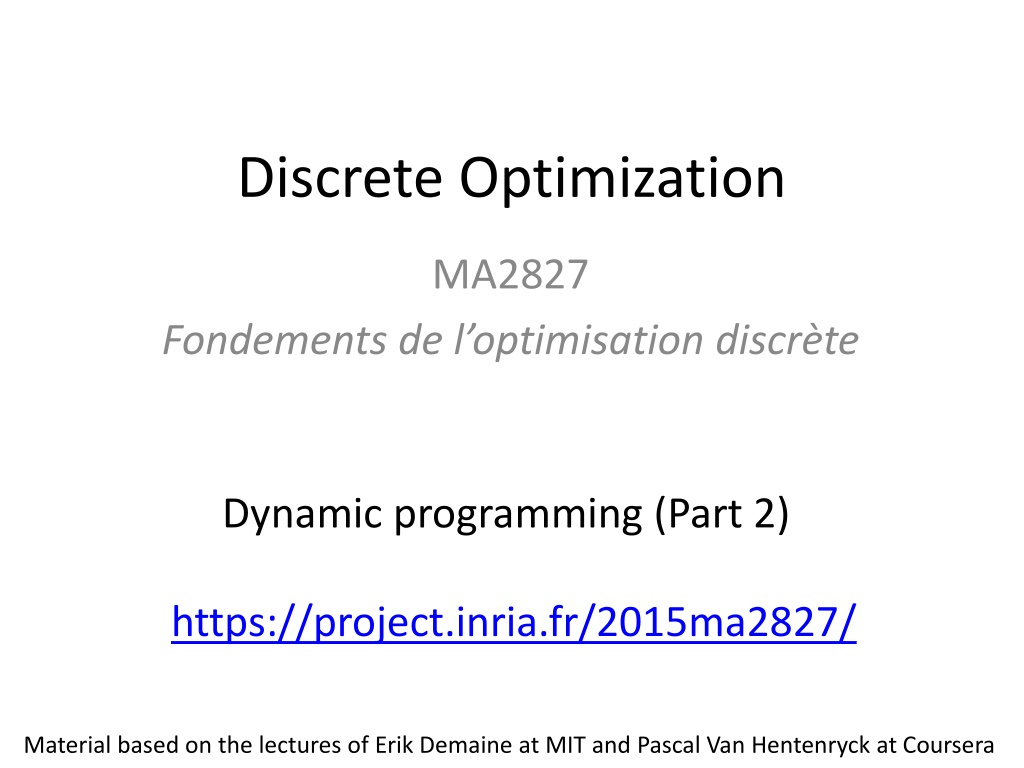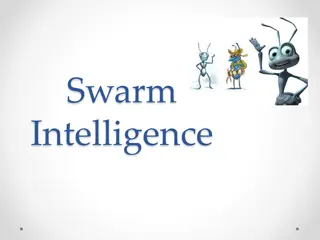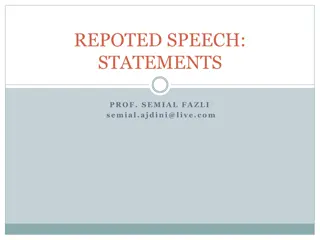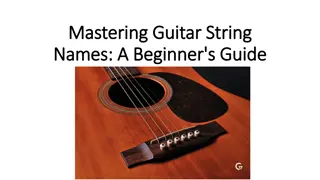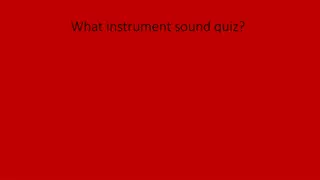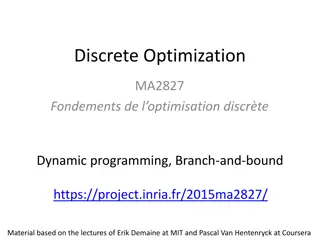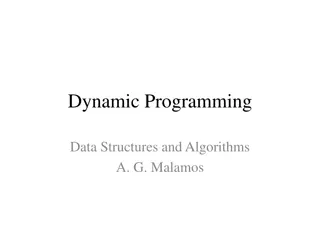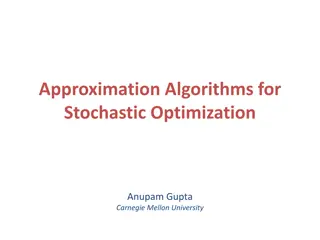Dynamic Programming for Guitar Fingering Optimization
Explore dynamic programming concepts applied to guitar fingering optimization, minimizing the overall difficulty of playing a melody. Learn how to define subproblems, make guesses, and use recursion to find the best finger for each note, ultimately solving the original problem efficiently.
Download Presentation

Please find below an Image/Link to download the presentation.
The content on the website is provided AS IS for your information and personal use only. It may not be sold, licensed, or shared on other websites without obtaining consent from the author.If you encounter any issues during the download, it is possible that the publisher has removed the file from their server.
You are allowed to download the files provided on this website for personal or commercial use, subject to the condition that they are used lawfully. All files are the property of their respective owners.
The content on the website is provided AS IS for your information and personal use only. It may not be sold, licensed, or shared on other websites without obtaining consent from the author.
E N D
Presentation Transcript
Discrete Optimization MA2827 Fondements de l optimisation discr te Dynamic programming (Part 2) https://project.inria.fr/2015ma2827/ Material based on the lectures of Erik Demaine at MIT and Pascal Van Hentenryck at Coursera
Outline Dynamic programming Guitar fingering More dynamic programming Tetris Blackjack Quiz: bracket sequences
Dynamic programming DP careful brute force DP recursion + memoization + guessing Divide the problem into subproblems that are connected to the original problem Graph of subproblems has to be acyclic (DAG) Time = #subproblems time/subproblem
5 easy steps of DP Analysis: #subproblems 1. Define subproblems #choices 2. Guess part of solution time/subproblem 3. Relate subproblems (recursion) time 4. Recurse + memoize OR build DP table bottom-up - check subprobs be acyclic / topological order extra time 5. Solve original problem
Guitar fingering Task: find the best way to play a melody
Guitar fingering Task: find the best way to play a melody Input: sequence of notes to play with right hand One note at a time! Which finger to use? 1, 2, , F = 5 for humans Measure d( f, p, g, q ) of difficulty to go from note p with finger f to note q with finger g Examples of rules: crossing fingers: 1 < f < g and p > q => uncomfortable stretching: p << q => uncomfortable legato (smooth): if f = g
Guitar fingering Task: find the best way to play a melody Goal: minimize overall difficulty Subproblems: min. difficulty for suffix note[ i : ] #subproblems = O( n ) where n = #notes Guesses: finger f for the first note[ i ] #choices = F Recurrence: DP[ i ] = min{ DP[ i + 1 ] + d( note[ i ], f, note[ i +1 ], next finger ) }
Guitar fingering Task: find the best way to play a melody Goal: minimize overall difficulty Subproblems: min. difficulty for suffix note[ i : ] #subproblems = O( n ) where n = #notes Guesses: finger f for the first note[ i ] #choices = F Recurrence: DP[ i ] = min{ DP[ i + 1 ] + d( note[ i ], f, note[ i +1 ], next finger ) } Not enough information!
Guitar fingering Task: find the best way to play a melody Goal: minimize overall difficulty Subproblems: min. difficulty for suffix note[ i : ] when finger f is on note[ i ] #subproblems = O( n F ) Guesses: finger f for the next note, note[ i + 1 ] #choices = F Recurrence: DP[ i, f ] = min{ DP[ i + 1, g ] + d( note[ i ], f, note[ i +1 ], g ) | all g } Base-case: DP[ n, f ] = 0 time/subproblem = O( F )
Guitar fingering Task: find the best way to play a melody Topological order: notes for i = n-1, n-2, , 0: for f = 1, , F: fingers total time = O( n F2 ) Final problem: find minimal DP[ 0, f ] for f = 1, , F guessing the first finger
Tetris Task: win in the game of Tetris!
Tetris Task: win in the game of Tetris! Input: a sequence of n Tetris pieces and an empty board of small width w Choose orientation and position for each piece Must drop piece till it hits something Full rows do not clear Goal: survive i.e., stay within height h
Tetris Task: stay within height h Subproblem: survival? in suffix [ i : ] given a particular column profile #subproblems = O( n (h+1)w ) Guesses: where to drop piece i? #choices = O( w ) Recurrence: DP[ i, p ] = max { DP[ i + 1, q ] | q is a valid move from p } Base-case: DP[ n+1, p ] = true for all profiles p time/subproblem = O( w )
Tetris Task: stay within height h pieces Topological order: for i = n 1, n 2, , 0: for p = 0, , (h+1)w 1: profiles total time O( n w (h+1)w ) Final problem: DP[ 0, empty ]
Blackjack Task: beat the blackjack (twenty-one)!
Blackjack Task: beat the blackjack! Rules of Blackjack (simplified): The player and the dealer are initially given 2 cards each Each card gives points: - Cards 2-10 are valued at the face value of the card - Face cards (King, Queen, Jack) are valued at 10 - The Ace card can be valued either at 11 or 1 The goal of the player is to get more points than the dealer, but less than 21, if more than 21 than he looses (busts) Player can take any number of cards (hits) After that the dealer hits deterministically: until 17 points
Perfect-information Blackjack Task: beat the blackjack with a marked deck! Input: a deck of cards c0, , cn-1 Player vs. dealer one-on-one Goal: maximize winning for a fixed bet $1 Might benefit from loosing to get a better deck
Quiz (as homework) Write the DP for perfect-information blackjack Derive the number of subproblems for the tetris problem
